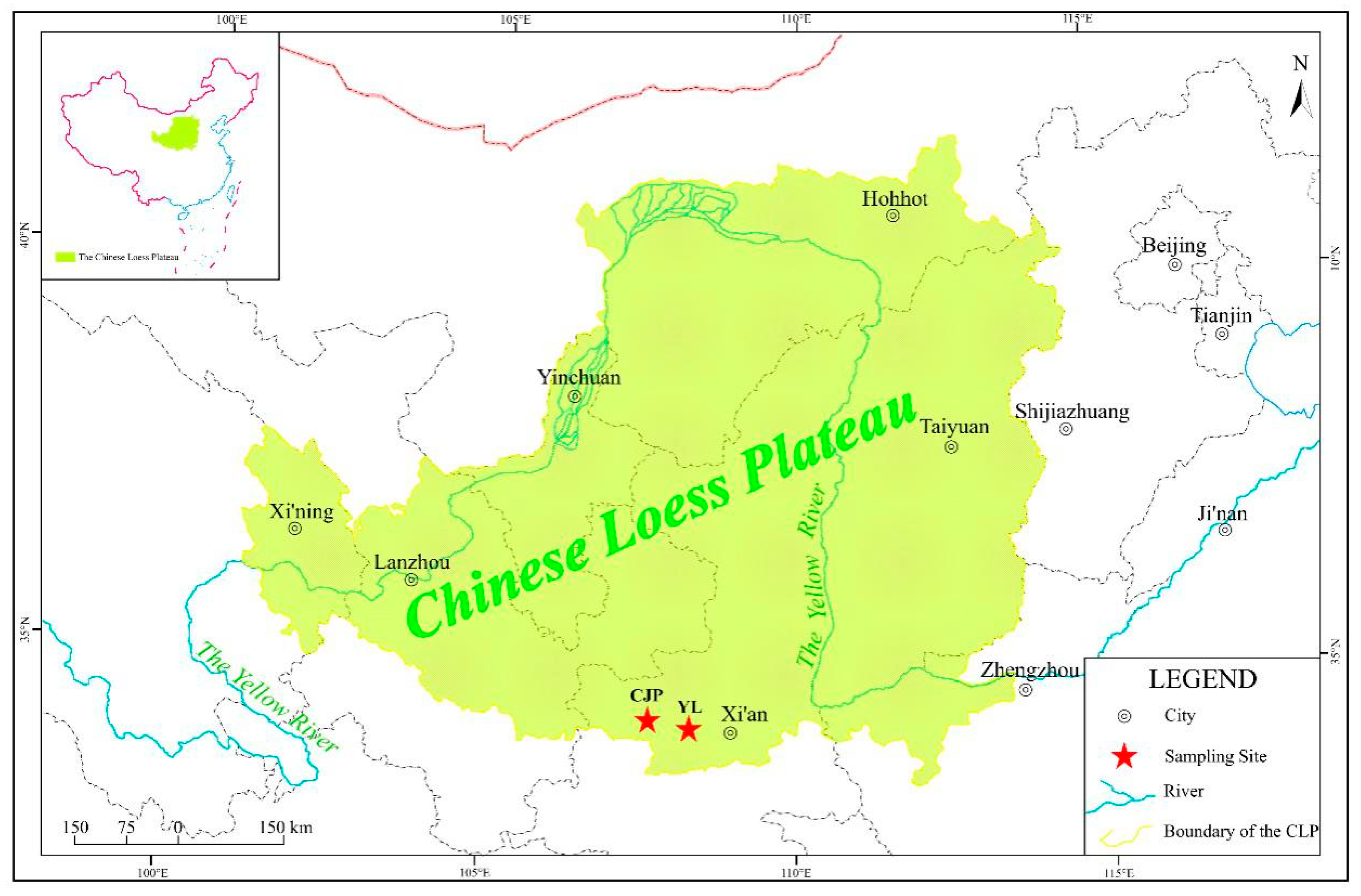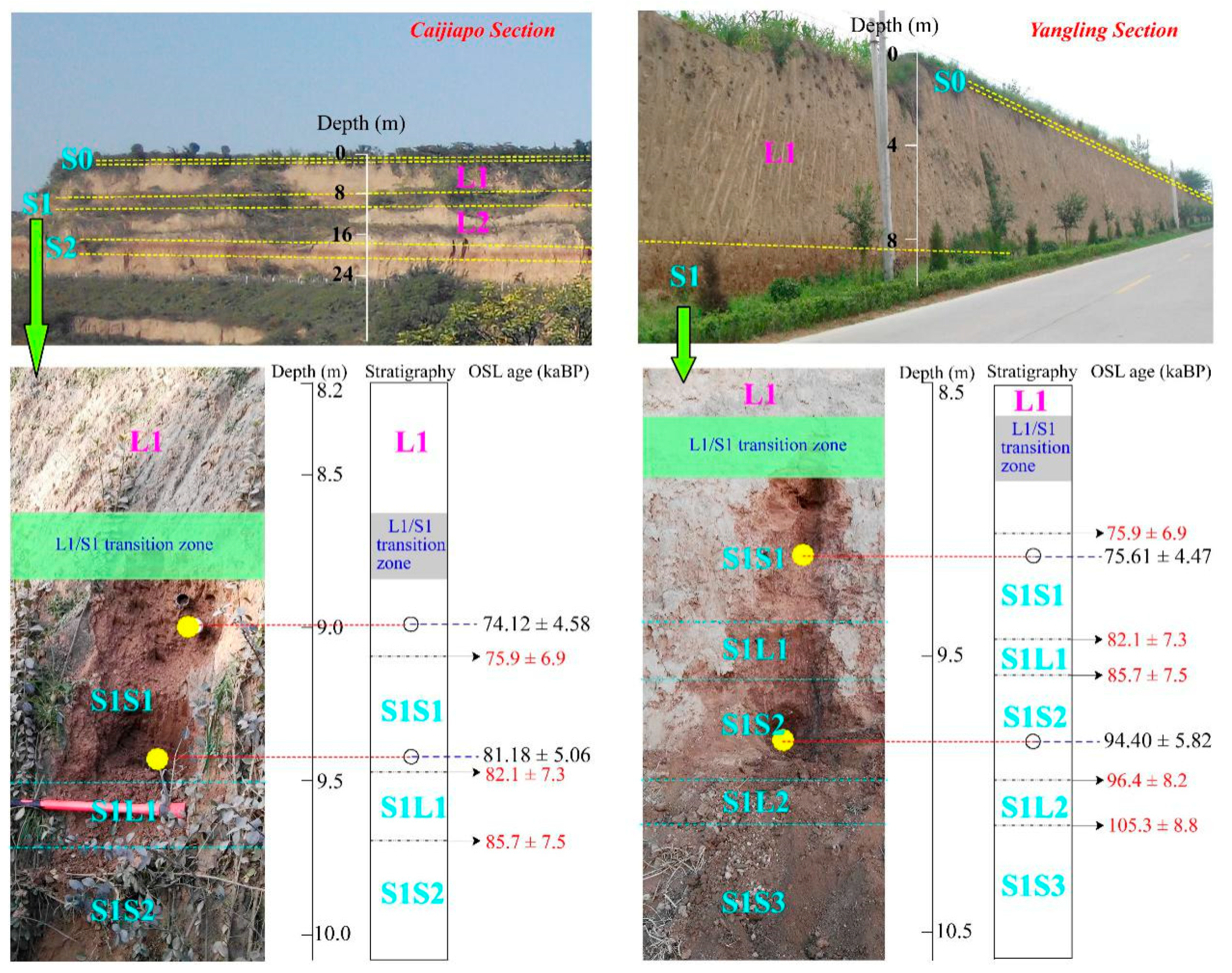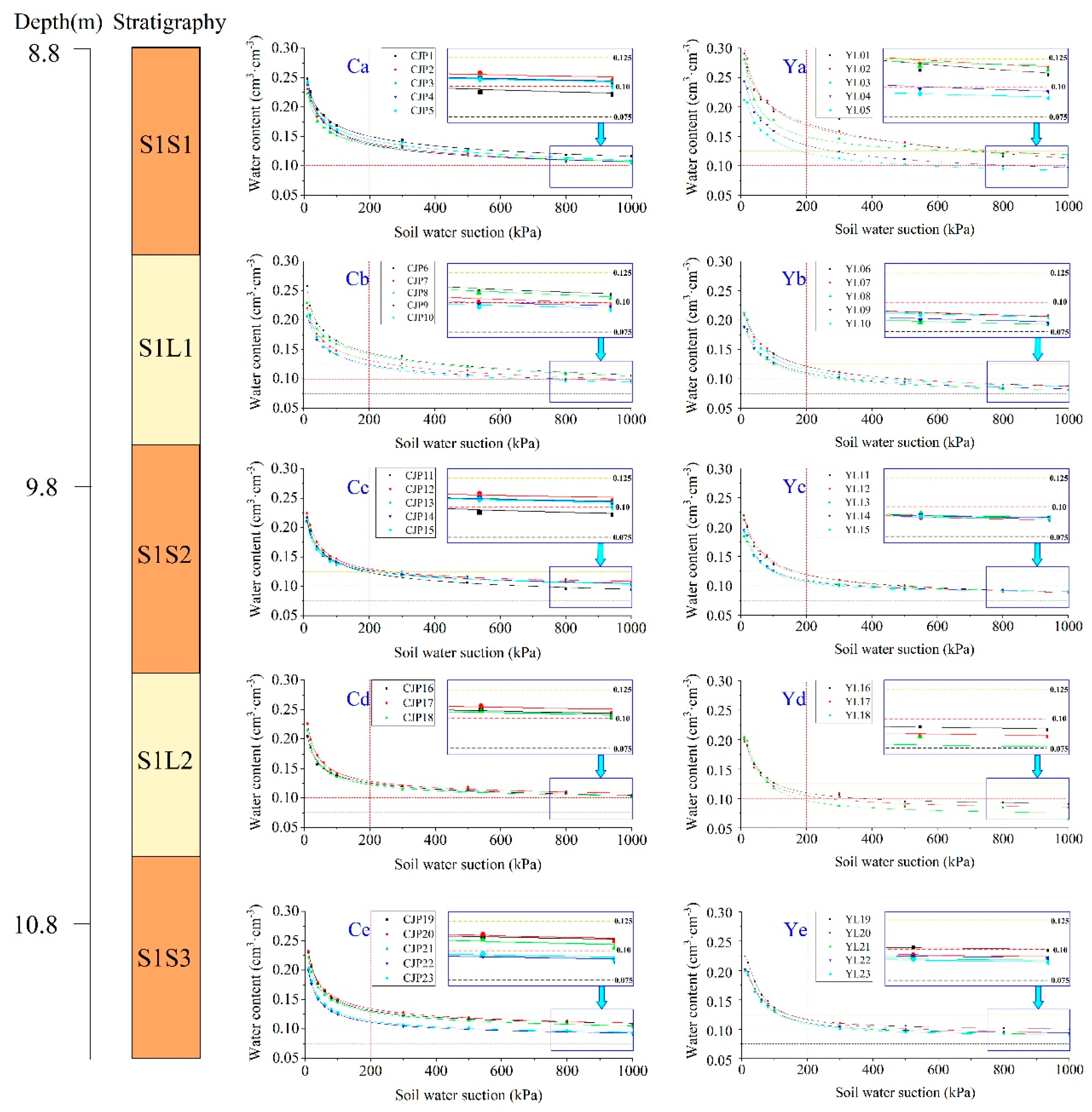Effects of Climatic Change on Soil Hydraulic Properties during the Last Interglacial Period: Two Case Studies of the Southern Chinese Loess Plateau
Abstract
1. Introduction
2. Materials and Methods
2.1. Site Description
2.2. Soil Sampling
2.3. Laboratory Measurements and Data Analysis
2.4. Chronology
2.5. Statistical Analysis
3. Results
3.1. Chronology of the Sampling Profiles
3.2. Basic Soil Properties
3.3. Soil Hydraulic Properties
3.3.1. Saturated Hydraulic Conductivity (Ks)
3.3.2. Soil Water Stable Aggregates (Macro-Aggregates, MA)
3.3.3. Hygroscopic Water Content (HWC)
3.3.4. Soil Water Characteristic Curves
3.4. Factors Affecting Soil Hydraulic Properties
4. Discussion
4.1. Climatic Evolution during the Last Interglacial
4.2. Soil Hydraulic Parameters: The Paleoenvironmental Record
4.3. Pedogenesis and Soil Water Properties
4.4. Compaction and Soil Hydraulic Properties
4.5. Effects of Precipitation on Soil Hydraulic Properties after the Development of Paleosols
5. Conclusions
- (1)
- The soil physio-chemical indexes revealed that the paleoclimate of the last interglacial in the study area could be divided into five sub-stages, including three warm and wet phases and two cool and dry phases. Soil hydraulic properties varied synchronously with climate fluctuation. Warm, wet climate produced more fine particles and strengthened pedogenic processes, which decreased the saturated hydraulic conductivity and increased the macro-aggregates content; cool, dry climate produced more coarse particles and weakened pedogenic processes, which increased the saturated hydraulic conductivity and decreased the macro-aggregates content.
- (2)
- Redundancy analysis revealed that clay content and total porosity were the main factors affecting the soil hydraulic properties. In the CJP profile, the clay content played a more important role than total porosity in affecting soil hydraulic properties; in the YL profile, the total porosity more influenced soil hydraulic properties than clay content. For both profiles, soil organic matter played only a minor role in soil hydraulic properties.
- (3)
- Although the influence could not be ignored, the precipitation since the last glacial and the compaction from the upper loess stratum (L1) did not destroy the soil hydraulic properties of S1.
Author Contributions
Funding
Acknowledgments
Conflicts of Interest
References
- Huang, C.C.; Pang, J.; Huang, P.; Hou, C.; Han, Y. High-resolution studies of the oldest cultivated soils in the southern Loess Plateau of China. Catena 2002, 47, 29–42. [Google Scholar] [CrossRef]
- Sun, J. Provenance of loess material and formation of loess deposits on the Chinese Loess Plateau. Earth Planet. Sci. Lett. 2002, 203, 845–859. [Google Scholar] [CrossRef]
- Kemp, R.A. Pedogenic modification of loess: Significance for paleoclimatic reconstructions. Earth Sci. Rev. 2001, 54, 145–156. [Google Scholar] [CrossRef]
- Porter, S.C.; An, Z. Correlation between climate events in the North Atlantic and China during the last glaciation. Nature 1995, 375, 305–308. [Google Scholar] [CrossRef]
- Liu, T.S. Loess and the Environment; China Ocean Press: Beijing, China, 1985; pp. 31–98. [Google Scholar]
- An, Z.S.; Liu, T.S.; Lu, Y.C.; Porter, S.C.; Kukla, G.; Wu, X.H.; Hua, Y.M. The long term paleomonsoon variation recorded by the loess-paleosol sequence in central China. Quat. Int. 1990, 7–8, 91–95. [Google Scholar]
- Zhang, J.; Li, J.J.; Guo, B.H.; Ma, Z.H.; Li, X.M.; Ye, X.Y.; Yu, H.; Liu, J.; Yang, C.; Zhang, S.D.; et al. Magnetostratigraphic age and monsoonal evolution recorded by the thickest quaternary loess deposit of the Lanzhou region, western Chinese Loess Plateau. Quat. Sci. Rev. 2016, 139, 17–29. [Google Scholar] [CrossRef]
- Feng, Z.D.; Wang, H.B.; Olson, C.; Pope, G.A.; Chen, F.H.; Zhang, J.W.; An, C.B. Chronological discord between the last interglacial paleosol (S1) and its parent material in the Chinese Loess Plateau. Quat. Int. 2004, 117, 17–26. [Google Scholar] [CrossRef]
- Müller, U.C.; Pross, J. Lesson from the past: Present insolation minimum holds potential for glacial inception. Quat. Sci. Rev. 2007, 26, 3025–3029. [Google Scholar] [CrossRef]
- Rao, Z.; Liu, X.; Hua, H.; Gao, Y.; Chen, F. Evolving history of the East Asian summer monsoon intensity during the MIS5: Inconsistent records from Chinese stalagmites and loess deposits. Environ. Earth Sci. 2014, 73, 3937–3950. [Google Scholar] [CrossRef]
- Chen, F.H.; Qiang, M.R.; Feng, Z.D.; Wang, H.B.; Bloemendal, J. Stable East Asian monsoon climate during the Last Interglacial (Eemian) indicated by paleosol S1 in the western part of the Chinese Loess Plateau. Glob. Planet. Chang. 2003, 36, 171–179. [Google Scholar] [CrossRef]
- Ma, L.; Hoogenboom, G.; Saseendran, S.A.; Bartling, P.N.S.; Ahuja, L.R.; Green, T.R. Effects of estimating soil hydraulic properties and root growth factor on soil water balance and crop production. Agron. J. 2009, 101, 572–583. [Google Scholar] [CrossRef]
- Wu, T.N.; Wang, Y.Q.; Lv, J.W.; Zhang, B. Soil water characteristics of Middle Pleistocene paleosol layers on the Loess Plateau. Afr. J. Biotechnol. 2011, 10, 10856–10863. [Google Scholar]
- Fedoroff, N.; Glodberg, P. Comparative micromorphology of two Late Pleistocene paleosols (in the Paris Basin). Catena 1982, 9, 227–251. [Google Scholar] [CrossRef]
- Zhao, J.B.; Luo, X.Q.; Ma, Y.D.; Zhou, Q.; Chen, B.Q.; Yue, Y.L. Climate and soil moisture content during development of the first palaeosol in the southern Loess Plateau. Eur. J. Soil Sci. 2018, 69, 462–474. [Google Scholar] [CrossRef]
- Ding, Z.L.; Yu, Z.W.; Yang, S.L.; Sun, J.M.; Xiong, S.F.; Liu, T.S. Coeval changes in grain size and sedimentation rate of eolian loess, the Chinese Loess Plateau. Geophys. Res. Lett. 2001, 28, 2097–2100. [Google Scholar] [CrossRef]
- Zhang, Z.; Zhao, M.; Eglinton, G.; Lu, H.; Huang, C. Leaf wax lipids as paleovegetational and paleoenvironmental proxies for the Chinese Loess Plateau over the last 170 kyr. Quat. Sci. Rev. 2006, 25, 575–594. [Google Scholar] [CrossRef]
- Zhao, J.B.; Ma, Y.D.; Cao, J.J.; Wei, J.P.; Shao, T.J. Effect of quaternary climatic change on modern hydrological systems in the southern Chinese Loess Plateau. Environ. Earth Sci. 2015, 73, 1161–1167. [Google Scholar] [CrossRef]
- Blanco-Canqui, H.; Wienhold, B.J.; Jin, V.L.; Schmer, M.R.; Kibet, L.C. Long-term tillage impact on soil hydraulic properties. Soil Till. Res. 2017, 170, 38–42. [Google Scholar] [CrossRef]
- Rahardjo, H.; Nong, X.; Lee, D.; Leong, E.; Fong, Y. Expedited soil-water characteristic curve tests using combined centrifuge and chilled mirror techniques. Geotech. Test. J. 2018, 41, 207–217. [Google Scholar] [CrossRef]
- Rahardjo, H.; Satyanaga, A.; Mohamed, H.; Ip, S.C.Y.; Shah, R.S. Comparison of soil-water characteristic curves from conventional testing and combination of small-scale centrifuge and dew point methods. Geotech. Geol. Eng. 2019, 37, 659–672. [Google Scholar] [CrossRef]
- Wang, X.; Benson, C. Leak-free pressure plate extractor for measuring the soil water characteristic curve. Geotech. Test. J. 2004, 27, 163–172. [Google Scholar]
- van Genuchten, M.T. A closed form equation for predicting the hydraulic conductivity of unsaturated soils. Soil Sci. Soc. Am. J. 1980, 44, 892–898. [Google Scholar] [CrossRef]
- Plante, A.F.; Conant, R.T.; Stewart, C.E.; Paustian, K.; Six, J. Impact of soil texture on the distribution of soil organic matter in physical and chemical fractions. Soil Sci. Soc. Am. J. 2006, 70, 287–296. [Google Scholar] [CrossRef]
- Stolte, J. Manual for Soil Physical Measurements, 3th ed.; DLO-Staring Centre: Wageningen, The Netherlands, 1997; pp. 33–38. [Google Scholar]
- Gwenzi, W.; Hinz, C.; Holmes, K.; Phillips, I.R.; Mullins, I.J. Field-scale spatial variability of saturated hydraulic conductivity on a recently constructed artificial ecosystem. Geoderma 2011, 166, 43–56. [Google Scholar] [CrossRef]
- Ding, Z.L.; Derbyshire, E.; Yang, S.L.; Yu, Z.W.; Xiong, S.F.; Liu, T.S. Stacked 2.6-Ma grain size record from the Chinese loess based on five sections and correlation with the deep-sea δ18O record. Paleoceanography 2002, 17, 1033. [Google Scholar] [CrossRef]
- Kang, S.; Lu, Y.; Wang, X.L. Closely-spaced recuperated OSL dating of the last interglacial paleosol in the southeastern margin of the Chinese Loess Plateau. Quat. Geochronol. 2011, 6, 480–490. [Google Scholar] [CrossRef]
- Chen, J.; Yang, T.; Matishov, G.; Velichko, A.; Zeng, B.; He, Y.; Shi, P. Luminescence chronology and age model application for the upper part of the Chumbur-Kosa loess sequence in the Sea of Azov, Russia. J. Mt. Sci. Eng. 2018, 15, 504–518. [Google Scholar] [CrossRef]
- Jia, J.; Gao, F.Y.; Xia, D.S.; Huang, W.; Chen, F.H. Moisture variations in arid central Asia and its out-of-phase relationship with the Asian Monsoon during MIS 5: Evidence from loess records. J. Quat. Sci. 2018, 33, 435–443. [Google Scholar] [CrossRef]
- Borcard, D.; Gillet, F.; Legendre, H.P. Numerical Ecology with R, 2nd ed.; Springer: New York, NY, USA, 2011; pp. 154–197. [Google Scholar]
- Pan, T.; Hou, S.; Wu, S.; Liu, Y.; Zou, X.; Herzberger, A.; Liu, J. Variation of soil hydraulic properties with alpine grassland degradation in the eastern Tibetan Plateau. Hydrol. Earth Syst. Sci. 2017, 21, 2249–2261. [Google Scholar] [CrossRef]
- van Genuchten, M.T.; Leij, F.J.; Yates, S.R. The RETC Code for Quantifying the Hydraulic Functions of Unsaturated Soils, 1st ed.; U.S. Salinity Laboratory: Riverside, CA, USA, 1991; pp. 4–32. [Google Scholar]
- Lü, T.; Sun, J.; Gong, Z. Optical dating of eolian deposits since the last interglacial along the northern margin of the Chinese Loess Plateau. J. Asian Earth Sci. 2018, 155, 154–163. [Google Scholar] [CrossRef]
- Bittelli, M.; Campbell, G.S.; Flury, M. Characterization of particle-size distribution in soils with a fragmentation model. Soil Sci. Soc. Am. J. 1999, 63, 782–788. [Google Scholar] [CrossRef]
- Lisiecki, L.E.; Raymo, M.E. A Pliocene-Pleistocene stack of 57 globally distributed benthic δ18O records. Paleoceanography 2005, 20, PA1003. [Google Scholar] [CrossRef]
- Lu, N.; Khorshidi, M. Mechanisms for soil-water retention and hysteresis at high suction Range. J. Geotech. Geoenviron. 2015, 141, 04015032. [Google Scholar] [CrossRef]
- Puckett, W.E.; Dane, J.H.; Hajek, B.F. Physical and mineralogical data to determine soil hydraulic properties. Soil Sci. Soc. Am. J. 1985, 49, 831–836. [Google Scholar] [CrossRef]
- Yilmaz, K.; Celik, I.; Kapur, S.; Ryan, J. Clay minerals, Ca/Mg ratio and Fe-Al oxides in relation to structural stability, hydraulic conductivity and soil erosion in southeastern Turkey. Turk. J. Agric. For. 2005, 29, 29–37. [Google Scholar]
- Peng, S.; Hao, Q.; Oldfield, F.; Guo, Z. Release of iron from chlorite weathering and links to magnetic enhancement in Chinese loess deposits. Catena 2014, 117, 43–49. [Google Scholar] [CrossRef]
- Lewis, C.J.; McDonald, E.V.; Sancho, C.; Peña, J.L.; Rhodes, E.J. Climatic implications of correlated upper Pleistocene glacial and fluvial deposits on the Cinca and Gállego Rivers, NE Spain. Glob. Planet. Chang. 2009, 67, 141–152. [Google Scholar] [CrossRef]
- Zhao, C.; Jia, X.; Gongadze, K.; Shao, M.; Wu, L.; Zhu, Y. Permanent dry soil layer a critical control on soil desiccation on China’s Loess Plateau. Sci. Rep. UK 2019, 9, 3296. [Google Scholar] [CrossRef]
- Li, X.; Zhou, J.; Dodson, J. The vegetation characteristics of the “Yuan” area at Yaoxian on the Loess Plateau in China over the last 12,000 years. Rev. Palaeobot. Palyno. 2003, 124, 1–7. [Google Scholar] [CrossRef]
- Chen, Z.Q.; Kavvas, M.L.; Yoon, J.Y.; Dogrul, C.; Fukami, K.; Yoshitani, J.; Matsuura, T. Geomorphic and soil hydraulic parameters for watershed environmental hydrology (WEHY) model. J. Hydrol. Eng. 2004, 9, 465–485. [Google Scholar] [CrossRef]
- Li, Y.R.; He, S.D.; Deng, X.H.; Xu, Y.X. Characterization of macropore structure of Malan loess in NW China based on 3D pipe models constructed by using computed tomography technology. J. Asian Earth Sci. 2018, 154, 271–279. [Google Scholar] [CrossRef]
- Ng, C.W.W.; Mu, Q.Y.; Zhou, C. Effects of soil structure on the shear behaviour of an unsaturated loess at different suctions and temperatures. Can. Geotech. J. 2017, 54, 270–279. [Google Scholar] [CrossRef]
- Cerdà, A. Soil aggregate stability in three Mediterranean environments. Soil Technol. 1996, 9, 133–140. [Google Scholar] [CrossRef]
- Brooks, S.M.; Richards, K.S. Establishing the role of pedogenesis in changing soil hydraulic properties. Earth Surf. Proc. Land. 1993, 18, 573–578. [Google Scholar] [CrossRef]
- Targulian, V.O.; Goryachkin, S.V. Soil memory: Types of record, carriers, hierarchy and diversity. Rev. Mex. Cienc. Geológicas 2004, 21, 1–8. [Google Scholar]
- Reible, D.D.; Popov, V.; Valsaraj, K.T.; Thibodeaux, L.J.; Lin, F.; Dikshit, M.; Todaro, M.A.; Fleeger, J.W. Contaminant fluxes from sediment due to tubificid oligochaete bioturbation. Water Res. 1996, 30, 704–714. [Google Scholar] [CrossRef]
- Hasioris, S.T.; Platt, B.F. Exploring the sedimentary, pedogenic, and hydrologic factors that control the occurrence and role of bioturbation in soil formation and horizonation in continental deposits: An integrative approach. Sediment. Rec. 2012, 10, 4–9. [Google Scholar] [CrossRef]
- Lin, H.S. Three principles of soil change and pedogenesis in time and space. Soil Sci. Soc. Am. J. 2011, 75, 2049–2070. [Google Scholar] [CrossRef]
- Lopes-Mazzetto, J.M.; Buurman, P.; Schellekens, J.; Martinez, P.H.R.M.; Vidal-Torrado, P. Soil morphology related to hydrology and degradation in tropical coastal podzols (SE Brazil). Catena 2018, 162, 1–13. [Google Scholar] [CrossRef]
- Horton, R.; Ankeny, M.D.; Allmaras, R.R. Effects of compaction on soil hydraulic properties. In Soil Compaction in Crop Production; Soane, B.D., van Ouwerkerk, C., Eds.; Elsevier: Amsterdam, The Netherlands, 1994; pp. 141–166. [Google Scholar]
- Richard, G.; Cousin, I.; Sillon, J.F.; Bruand, A.; Guérif, J. Effect of compaction on the porosity of a silty soil: Influence on unsaturated hydraulic properties. Eur. J. Soil Sci. 2001, 52, 49–58. [Google Scholar] [CrossRef]
- Zhang, S.L.; Grip, H.; Lovdahl, L. Effect of soil compaction on hydraulic properties of two loess soils in China. Soil Till. Res. 2006, 90, 117–125. [Google Scholar] [CrossRef]
- Mahmoodlu, M.G.; Raoof, A.; Sweijen, T.; van Genuchten, M. Effects of sand compaction and mixing on pore structure and the unsaturated soil hydraulic properties. Vadose Zone J. 2016, 15. [Google Scholar] [CrossRef]
- Nugteren, G.; Vandenberghe, J.; van Huissteden, J.K.; An, Z. A quaternary climate record based on grain size analysis from the Luochuan loess section on the central Loess Plateau, China. Glob. Planet. Chang. 2004, 41, 167–183. [Google Scholar] [CrossRef]
- Qiao, J.B.; Zhu, Y.J.; Jia, X.X.; Huang, L.M.; Shao, M.A. Estimating the spatial relationships between soil hydraulic properties and soil physical properties in the critical zone (0–100 m) on the Loess Plateau, China: A state-space modeling approach. Catena 2018, 160, 385–393. [Google Scholar] [CrossRef]
- Lin, H. Linking principles of soil formation and flow regimes. J. Hydrol. 2010, 393, 3–19. [Google Scholar] [CrossRef]
- Ning, Y.; Liu, W.; An, Z. A 130 ka reconstruction of precipitation on the Chinese Loess Plateau from organic carbon isotopes. Palaeogeogr. Palaeoclimatol. Palaeoecol. 2008, 270, 59–63. [Google Scholar]
- Maher, B.A.; Thompson, R. Paleorainfall reconstructions from pedogenic magnetic susceptibility variations in the Chinese loess and paleosols. Quat. Res. 1995, 44, 383–391. [Google Scholar] [CrossRef]
- Zhao, C.; Shao, M.; Jia, X.; Huang, L.; Zhu, Y. Spatial distribution of water-active soil layer along the south-north transect in the Loess Plateau of China. J. Arid Land 2019, 11, 228–240. [Google Scholar] [CrossRef]






| Profile | Factors * | Explains (%) | Contribution (%) | p |
|---|---|---|---|---|
| CJP | Clay content | 44.5 | 62.4 | 0.002 |
| Porosity | 25.9 | 36.3 | 0.008 | |
| SOM | 1.2 | 0.6 | 0.57 | |
| YL | Clay content | 17.6 | 25.5 | 0.002 |
| Porosity | 49.3 | 71.5 | 0.002 | |
| SOM | 2.0 | 3.0 | 0.286 |
© 2020 by the authors. Licensee MDPI, Basel, Switzerland. This article is an open access article distributed under the terms and conditions of the Creative Commons Attribution (CC BY) license (http://creativecommons.org/licenses/by/4.0/).
Share and Cite
Wu, T.; Lin, H.; Zhang, H.; Ye, F.; Wang, Y.; Liu, M.; Yi, J.; Tian, P. Effects of Climatic Change on Soil Hydraulic Properties during the Last Interglacial Period: Two Case Studies of the Southern Chinese Loess Plateau. Water 2020, 12, 511. https://doi.org/10.3390/w12020511
Wu T, Lin H, Zhang H, Ye F, Wang Y, Liu M, Yi J, Tian P. Effects of Climatic Change on Soil Hydraulic Properties during the Last Interglacial Period: Two Case Studies of the Southern Chinese Loess Plateau. Water. 2020; 12(2):511. https://doi.org/10.3390/w12020511
Chicago/Turabian StyleWu, Tieniu, Henry Lin, Hailin Zhang, Fei Ye, Yongwu Wang, Muxing Liu, Jun Yi, and Pei Tian. 2020. "Effects of Climatic Change on Soil Hydraulic Properties during the Last Interglacial Period: Two Case Studies of the Southern Chinese Loess Plateau" Water 12, no. 2: 511. https://doi.org/10.3390/w12020511
APA StyleWu, T., Lin, H., Zhang, H., Ye, F., Wang, Y., Liu, M., Yi, J., & Tian, P. (2020). Effects of Climatic Change on Soil Hydraulic Properties during the Last Interglacial Period: Two Case Studies of the Southern Chinese Loess Plateau. Water, 12(2), 511. https://doi.org/10.3390/w12020511






